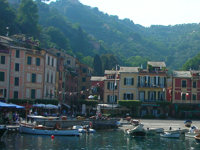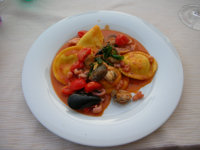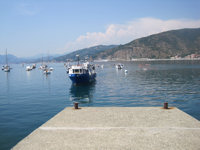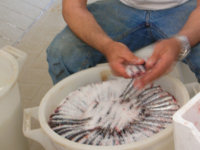Hitting the Italian food trail in Liguria
With the rise of gastro-tourism seeing more holidaymakers choose a destination based on its culinary merits rather than its more traditional sightseeing attractions, the northern Italian region of Liguria is coming into its own.
It’s not that the region is totally overlooked exactly – after all, it does encompass the ever popular Cinque Terre and the Italian Riviera. But the traditional popularity of the great classical cities such as Rome, Venice and Florence, or the romance of the Tuscan countryside mean that when planning a trip to Italy, Liguria does tend to come somewhere towards the bottom of the list.
 Landscape and food both inspire at Portofino
Landscape and food both inspire at PortofinoJane Duru
 Tasty seafood ravioli are a local delicacy
Tasty seafood ravioli are a local delicacyJane Duru
The setting is rather less glamorous the next day, though no less beautiful. We’re off to see the tonnarella in Camogli, a small town on the riviera around 90 minutes east of Genoa. The tonnarella (tuna net) is one of the last five remaining in Italy, and whilst it’s a very sustainable way of catching fish, the centuries old practice is a dying art as young people become less interested in learning to fish using the traditional methods. From April to September, the nets are let down into the sea, as the fish make their migratory route through the bay, and three times a day, a six man crew lifts the nets to take the catch. Sustainable and ethical, the nets are made so that they are able to filter out the smaller local fish which aren’t wanted, whilst the rest period during the winter months means that fish stocks are able to replenish. Ziguele, an organisation set up by three young local marine biologists to promote this way of fishing, take us on an early morning tour to see the fishermen raise the nets.
 Try your hand at fishing with the locals
Try your hand at fishing with the localsLiguria Tourism
 Learning how to salt anchovies
Learning how to salt anchoviesJane Duru
Sommariva produce several blends, one of the finest being ‘Cru Seena’ certified extra virgin olive oil D.O.P (Protected Denomination of Origin) Ligure. But it’s the taggiasche olives that I’ll remember – small, and black, they have such intensity of flavour that the humble Kalamata can’t compete. Then there’s their award-winning pesto Genovese, a jar of which is on my must-buy list.
Both producers are adherents to the philosophy of Slow Food, a movement which was started by Italian Carlo Petrini in 1986. Opposed to ‘fast food,’ and junk food culture, Slow Food aims to encourage locally grown produce and authentic techniques of preparation. I visit the biennial Slow Fish festival, where the Camogli fishermen have a stall. Part trade fair, exhibition and market, it is full of excitable children on school trips, curious holidaymakers, and serious foodies, all here to sample the overwhelmingly wide range of dishes on offer, and meet artisan producers from all over Italy. If you’re in town when it’s on, it’s worth booking a ticket.
The next day, we are sitting on the deck of Il Castel Dragone, a slightly worn looking fishing vessel manned by fishermen that run fishing tours of coastline, on our way to AQUA, a local aquaculture (fish farm). Some fish farms have a questionable reputation in terms of the environmental impact and quality of fish produced but here, special care is taken to make sure that the sea bass and sea bream are produced in a sustainable way, with no negative effect on the marine environment. Fish levels are kept to around 10-15 per cubic metre (as opposed to 40-50 in other farms) and the feed is free of the additives that other farms commonly use to make the fish grow faster. As farmed fish go, it’s high quality stuff.
After the aquaculture and a hospitable lunch at Il Bistro Mare, a friendly home-run restaurant in Sestri Levante, all anyone wants to do is nap. We’re on the way to Portofino, playground of the rich and famous. Dolce and Gabbana have a home here, and this is where Richard Burton proposed to Elizabeth Taylor. But none of that matters at the moment; sleep is on my mind. Eyelids start to droop, my limbs feel heavy, I’m almost asleep – and then there’s a shout of ‘look over there!’ I’m startled awake; sleep will have to wait.
The mood on board has veered from soporific to frothy excitement. Everyone is peering over the side of the boat, cameras in hand, impatient in anticipation. Suddenly I see what caused the commotion. Parallel to us, no more than 50m away, is the unmistakably sinuous curve of a dolphin leaping through the glittering ocean. Three of them in fact, playfully leaping in unison. It’s a lovely sight to behold and the whole boat is enthralled by the unexpected sight of these beautiful creatures. “Portofino, port of dolphins” relays Cristina our guide, by way of explanation. And with that, it seems that whilst the gastro-tourist will certainly delight in the foodie charms of Liguria, there’s always room for a bit of good old fashioned sightseeing.
What to take? Sensible shoes (it’s a mountainous region and steep climbs are par for the course).
What to bring home? A jar of pesto Genovese.
What to eat? Farinata (tasty chickpea flour pancakes), pigato wine (a white wine specific to Liguria; it goes well with fish), and pandolce (sweet bread made with chestnut flour and stuffed with nuts and dried fruits).
Where to splash out? Il Vescovado, a Michelin-starred restaurant in Noli, set inside a 14th-century Bishop’s residential palace, and with stunning views of the bay.
When should foodies go? Pesto e Dintorni, an annual food festival dedicated to all things pesto takes place in Lavagna, Genoa, in October. Olive oil connoisseurs should head to Olioliva, an olive oil festival, taking place from 25th -27th November in Imperia, Oneglia.
Need to know:
Fly: British Airways flies to Genoa. Flights from £49.
Stay: NH Marina in Genoa, is right on the waterfront. Double rooms start from €114.
Useful regional information: Liguria Tourism
Do you have any Feedback about this page?
© 2025 Columbus Travel Media Ltd. All rights reserved. No part of this site may be reproduced without our written permission, click here for information on Columbus Content Solutions.









 You know where
You know where